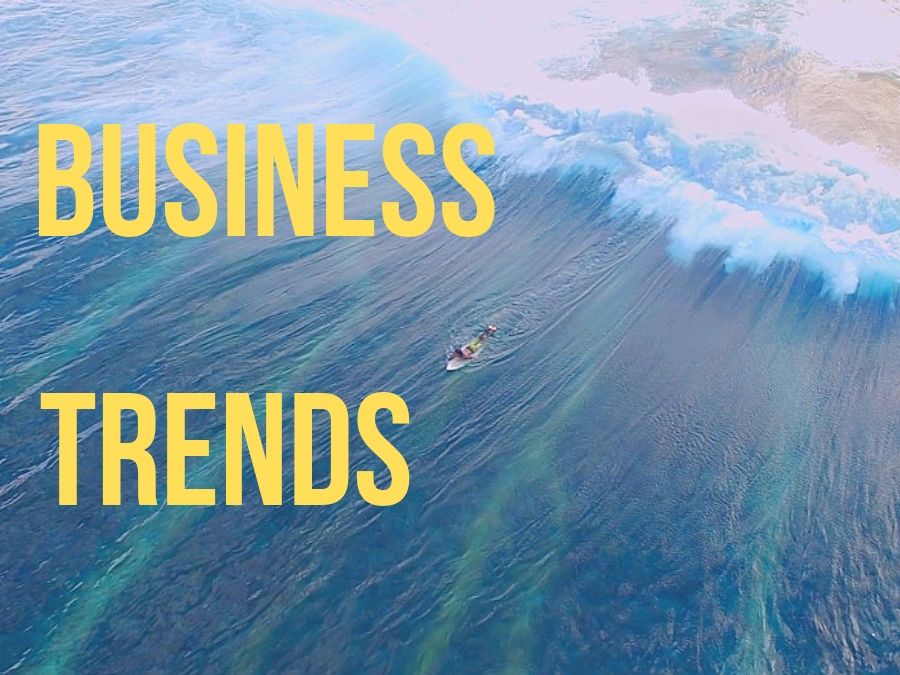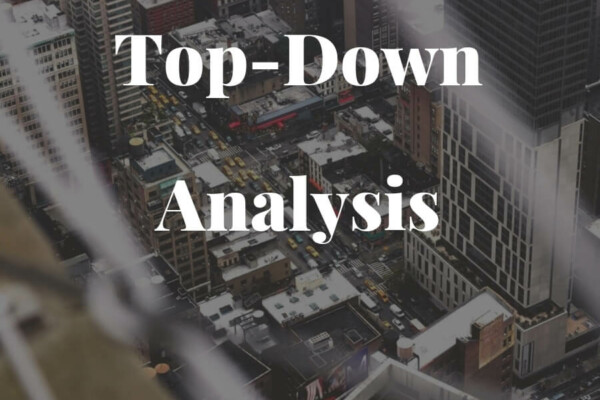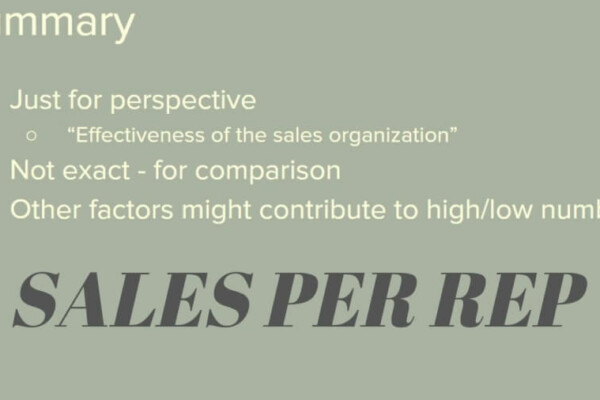Is Foot Locker capitalizing on industry trends?
I used Foot Locker as an example in my post on estimating the market size. So, I’ll do the same here.
Keep in mind, this is a subjective exercise. I don’t shop at Foot Locker or claim to be an expert in the athletic fashion/athleisure industry. I literally picked Foot Locker at random.
While I do think that investors should stick to industries they are familiar with, I thought this would be a good opportunity to learn a little about something new. Since I’m not planning to invest in Foot Locker per se, only trying to convey my understanding of Philip Fisher’s points, I didn’t see any harm in getting out of my lane a bit.
So, if you’re new to this sort of thing, you’ll be learning right alongside me. I’ll apply the steps I outlined above to a real-life company, and we’ll see what I come up with.
“Athleisure trends 2019”
We’ll start
This was my first search. Not all results were spot on, but on the first page, there looked to be some good options in terms of information.
I try to dress well, but I’m no expert on fashion. To me, it’s tricky. You have, on the one hand, what’s popular and sells a lot. On the other, you have the wacky, impractical, stuff you see getting marched down the runway at fashion shows.
As a 40-year-old guy from the Midwest who has no interest in runway fashion, I need to be careful not to let my preconceived notions get in my way here.
Result 1 – Product & service
That being said, the first result I clicked on, wasn’t really what I was looking for – I don’t think.
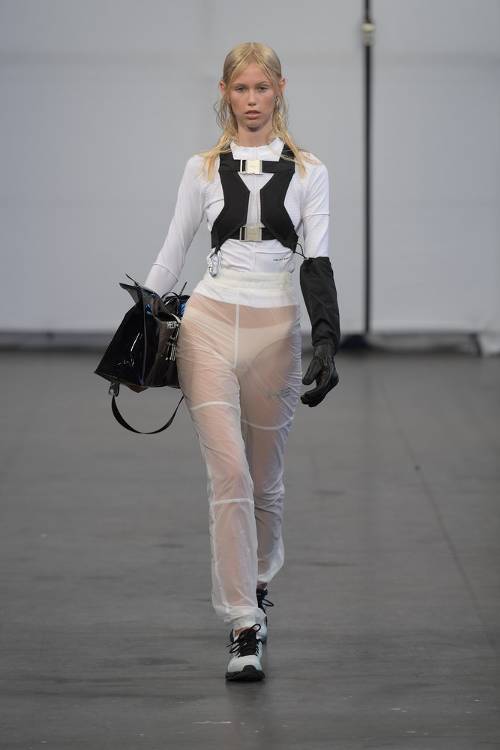
Maybe in the year 3019, this will be the sort of thing that flies off of Foot Locker’s shelves. But, I don’t think Foot Locker would be foregoing a lot of sales by not stocking clothing of this sort in 2019.
However, I’m just getting started in my research, so I might be wrong…
Result 2 – Product & service
The next result I decided to click on (not the 2nd result, per se) seemed to be a little more practical. Though the article was from mid-2018, the content seemed timely enough.
After scrolling through all 15 slides, a couple of themes stuck out to me:
- Stripes
- Floral prints
- Color blocking
- Jumpsuits
- Cutouts
With that noted, I moved on.
Result 3 – Product & service
I checked one more result with this search term. Obviously, it might make sense for you to check more than three results if you’re doing a similar sort of research. But, for the sake of brevity, I’ll try to keep things simple in this example.
This site had its expected athleisure trends buried in the text. But, after reading those, I gleaned the following:
- Cutouts in yoga pants
- High-waisted yoga pants
- Men’s technical (?) joggers
- “Cropped” apparel
Let’s move on to a different search.
“Retail industry outlook 2019”
With a little bit of an idea of what’s hot in the athleisure segment, we’ll now shift focus to the broader industry trends. Trends of this sort might have more to do with operations, not just sales. Researching this sort of information will hopefully help to round out our knowledge about the direction Foot Locker should be heading.
Result 1 – Operational
The first result I looked at provided some good information. Granted, this is just one person’s opinion – but it offered six strategies for retailers to remain competitive in the coming years.
Here are some takeaways that I want to investigate further:
- A loyalty program
- Mining customer data for insights
- Online-to-offline strategies
- Last-mile delivery
- Supply chain as a service and efficiency
- Social commerce
- Customer privacy policies
This was a good resource. A lot to follow up on here. Discerning whether or not Foot Locker is on board with these trends might be challenging. Not to mention, ascertaining if they even should be on board.
Again, we’re just looking to get a general idea of Foot Locker’s “trendiness” here, not come up with an iron-clad score of said trendiness.
Result 2 – Operational
The second result for this search term was a bit of a mixed bag.
Some of the trends addressed in the article seemed to be put in there merely for the sake of adding buzzwords. Terms like AI, machine learning, blockchain, and others were mentioned with no real-life application of how a retailer like Foot Locker would use these technologies. A bunch of fluff.
But, once I got past that, there were some practical trends to investigate on the part of Foot Locker. For example:
- Transparency in sustainability
- Robotics (particularly in a warehouse setting)
Sometimes you have to dig a little for information. This post could have given me what I need in about 300 words. But, I know the struggle to rank in search engines is real. So, I can’t fault them for writing something long-winded.
Result 3 – Operational
Finding a worthwhile third result took a little bit of looking. Here’s what I settled on.
This article was a good find because it approached things from a somewhat different angle than the previous two. The trends mentioned here focused on things that brick-and-mortar retailers are doing in-store to spur sales.
These trends included the following:
- Selling experiences along with products
- Utilizing the Internet of Things
- Marketing via augmented reality
What does Google Trends have to say about what I found?
With a solid set of trends to investigate, I’ll move on to Google Trends. Here, I’ll hope for illustration and clarification of how hot these trends really are.
“Striped leggings” and “stripe yoga pants”
Since terms like “stripes,” “floral prints, and “color blocking” are kind of generic, I decided to combine them with articles of clothing (yoga pants, legging, jumpsuits) when digging for terms to research on Google Trends.
Here’s what I found first:
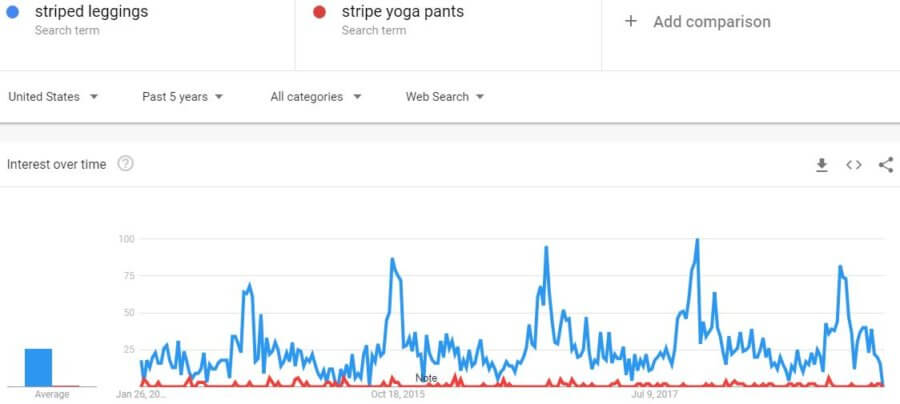
Searches for “striped leggings” dwarf searches for “stripe yoga pants.” They are also very seasonal with volume peaking in mid-October – which, makes sense. It also appears to me, that each year the highs were higher and the lows were higher – indicating an upward trend. That is…until this past year.
Maybe the trendy sites I referred to were wrong and striped leggings are starting to wane in popularity? Or, maybe women just searched for this term more on specific retailer’s sites and less on Google?
Let’s move on…
“Fitness jumpsuit,” “workout bodysuit,” and “yoga jumpsuit”

The trend and seasonality on jumpsuits and bodysuits aren’t quite as easy to interpret. To me, it looks like interest was sporadic about five years ago. Since then, “workout bodysuit” and “yoga jumpsuit” in particular look like they might be at the beginning stages of exponential growth.
I can’t know for sure, but the trend definitely looks like it’s on the upswing for this particular type of athleisure fashion. I would be somewhat concerned if Foot Locker wasn’t offering these types of items to their customers.
“Floral print leggings” and “high waisted leggings”

The image above shows that “floral print leggings” aren’t even something that is consistently searched for. “High waisted leggings,” on the other hand, are starting to take off.
I feel like I’m starting to get a better grasp on the trends in the athleisure industry. For starters, most of the trends revolve around women. Only one of the bullet points listed in part 1 was for men’s clothing (“technical joggers”). The other thing that stands out to me is that fit seems to show more pronounced trends than the style (floral, stripes, etc).
Let’s see how those assumptions hold up as I push on…
“Tech fleece joggers” and “cropped hoodie”

“Cropped hoodie” is another term that seems to be taking off. It’s also another
At this point, we’ve covered, more or less, all of the product-related trends I found. Let’s see what Google Trends has to tell us about the operational/industry trends.
“Online to offline,” “customer privacy,” and “loyalty program”
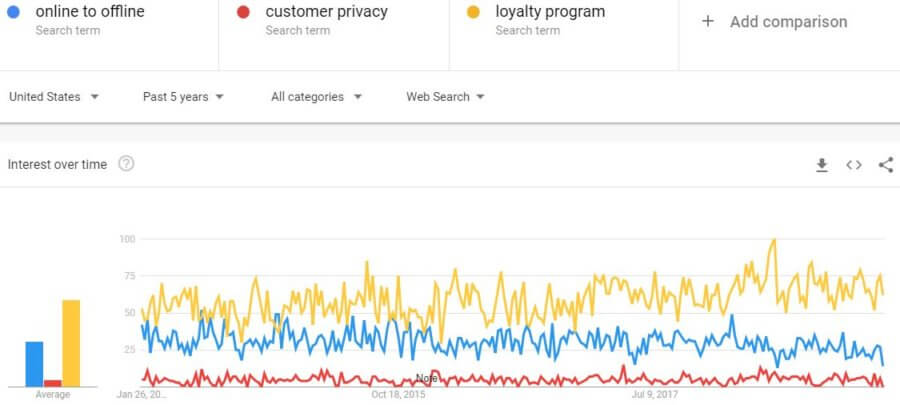
Since they aren’t consumer-related, Google Trends didn’t have insights on many of the operational trends mentioned in part 1. Most of the graphs were pretty erratic and showed zero interest throughout a lot of the past five years. Some had little or nothing to do with the sales side of Foot Locker’s business. That doesn’t mean that I shouldn’t investigate, just that those topics are beyond the scope of this post (Philip Fisher’s Point 1).
“Loyalty program,” in particular caught my attention. Not only is it the top searched of the three terms, it seems to be trending slowly upward. I’ll definitely have to check if Foot Locker has some sort of loyalty program.
Conversely, “online to offline” seems to be trending slowly downward. There’s still interest in the concept, but maybe it’s not as trendy as I was led to believe.
Finally, it’s hard to tell from the image, but “customer privacy” is also slowly trending upward. I would have expected this term to be more popular considering the attention given to the subject over the past several years.
What about sneakers?
It dawned on me after I had started my research that Foot Locker’s main business is sneakers/athletic shoes. Hell, it’s even in the title of their homepage. The information I found on athleisure trends didn’t address that particular item of clothing.
There’s a lesson here – make sure you’re asking the right questions.
I think the above examples of leggings, jumpsuits, etc serve as a good illustration of how I would go about this type of analysis. However, below is a brief rundown of what I found in terms of sneaker trends. Finding this info took a little more digging than I expected.
First of all, I focused my search on trends in male sneakers. I did this because male clothing trends were underrepresented in the earlier searches. Plus, per Foot Locker’s 2018 10-K SEC filing, “A substantial portion of our highest margin sales are to young males (ages 12-25).”
That being the case, I definitely want to have some idea of what’s trendy for this age group. After a bit of digging, here’s what I found:
- Minimalist styles (Common Projects)
- Classical styles (Converse One Star)
- Tech runners (Nike Epic React)
“White sneakers,” “classic sneakers,” and “technical sneakers”
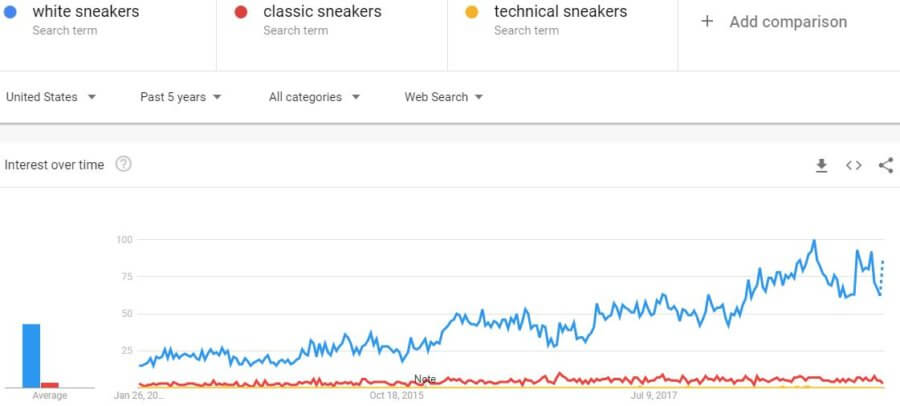
Looking at (variations of) these terms in Google Trends shows that “classic sneakers” (somewhat) and “white sneakers” (for sure) are trending upwards. “Technical sneakers,” not so much.
Let’s take a look at Trendhunter
Like I mentioned previously – you have to take Trendhunter with a grain of salt. It’s a very comprehensive website. But, not everything mentioned on there is “the next big thing.” Some of it is downright weird. Trendhunter’s comprehensiveness, however, increases the likelihood of you finding what you’re looking for.
I searched “site:trendhunter.com [search term]” and used the Tools option to narrow the date down to the past five years.
I did get some interesting results that made me circle back to Google Trends (e.g. one-piece running suits, plus-sized & reversible leggings). But, nothing that I was going to add to my list of trends.
Most of what I searched for didn’t have a match on Trendhunter. One exception was “cropped hoodies.” On Trendhunter, the term was only given a score of 2.2; which implies it’s not all that popular. This might seem to run in contrast to what Google Trends told me.

However, keep in mind that Google Trends only showed that interest was growing. Compared to “tech fleece joggers” there seemed to be a lot of interest. But, that doesn’t give the full picture.
Keep in mind that Google Trend’s charts are proportional, not absolute. So, it’s all about what term you’re comparing to. To put things in perspective, let’s compare “cropped hoodie” with plain
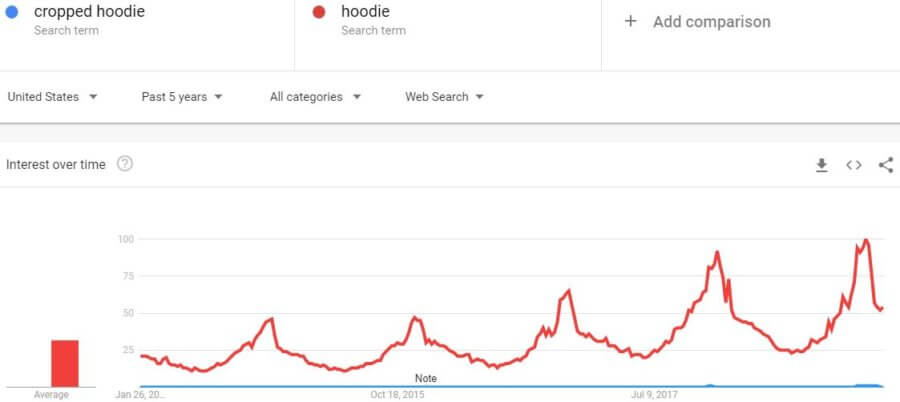
As you can see, “cropped hoodie” pales in comparison. So, that tells me that Trendhunter isn’t wrong. Cropped hoodies aren’t terribly popular – yet. But, their popularity seems to be increasing every year.
Trendhunter also provides insight beyond consumer items. All three of the operational trends (or derivatives thereof) were addressed by Trendhunter. In particular, the “customer loyalty” trend was addressed in-depth.
Lastly, I wanted to see what Trendhunter had to say about the sneaker trends I uncovered. In all three instances, not only did Trendhunter confirm the trend, but had pages with the exact shoe that I had used as an example.
How trendy is Foot Locker?
After a lot of searching and learning about Foot Locker’s industry, it’s time to size them up. There’s no way, that I know of, to quantify how well Foot Locker (or any company) takes advantage of trends. So, determining that is going to be a subjective undertaking.
The best I can hope to do is take some notes and decide for myself how well positioned this company is to ride the waves. How well it’s positioned to realize its serviceable obtainable market (SOM) and enjoy a “sizable increase in sales” for the next several years.
Getting a feel for the trendiness of Foot Locker’s products is easy enough – I just look at their family of websites (footlocker.com, ladyfootlocker.com, champssports.com, and so on).
Understanding the trendiness of Foot Locker’s operations probably won’t be as easy. I’ll have to refer to publicly available information in the form of SEC filings, news articles, press releases, and other similar sources.
Foot Locker products
Striped leggings/yoga pants
A search across footlocker.com, ladyfootlocker.com, six02.com, and easybay.com for “leggings stripe” shows that all these sites seem to carry similar products. It was only on six02.com that I saw anything that wasn’t manufactured by Adidas (and therefore
In Foot Locker’s defense, this was a very seasonal trend and wasn’t necessarily trending upwards. At least according to Google Trends.
Bodysuits/jumpsuits
Okay – this one concerns me a bit. Most of what I found on Foot Locker’s sites resembled one-piece swimsuits more than what I saw earlier when researching trends. The only exception was, again, on six02.com – which had more options that I would consider “trendy.”. In fairness, I have to check myself, though. We are way out of my area of expertise here.
High-waisted leggings
Each site I checked, except champssports.com, had a fair amount of results for “high waist leggings.” However, to my untrained eye, a lot of the results looked to be more functional than fashionable
I would expect as much from some of Foot Locker’s more utilitarian brands like eastbay.com. But, on the typically fashionable footlocker.com and six02.com, I was a little disappointed to find the same thing.
Cropped hoodie
No shortage of results for “crop hoodie.” Every Foot Locker site I checked had a pretty good variety of this particular trend. Even kidsfootlocker.com had several options available.
Tech fleece joggers
The only men’s item (white sneakers notwithstanding) on the trend list was also pretty well represented on Foot Locker’s websites. Six02.com didn’t have any results, but that might have been expected since that site’s niche seems to be women’s athleisure wear.
I was somewhat surprised, however, to find no results on kidsfootlocker.com. I (maybe incorrectly) assumed that this site’s purpose was to allow parents to dress their kids like themselves. Tech fleece joggers don’t strike me as solely an “adult” article of clothing. So, I’m left to wonder why these aren’t available
White sneakers
This was a mixed bag of results. A search on the sites for “white sneakers” didn’t turn up much. So, I had to search
First of all, I couldn’t find “Common Projects” on any of their sites. It might be because that particular manufacturer chooses not to market their product through Foot Locker. If so, that would seem to be Foot Locker’s loss. Common Projects white sneakers run $200+ so there would seem to be money to be made there. I don’t see any reason why this particular brand would be inconsistent with Foot Locker’s niche. This would be a good question for Foot Locker’s Investor Relations.
Next, I searched for “Converse One Star.” Not terribly encouraged by what I found here either. The only white One Star’s I found were for young boys. None for men, i.e. their bread and butter demographic (young males age 12-25). I suppose it’s possible that they sold out after Christmas?
Finally, I searched for “Nike Epic React.” Like the One Star’s, there were plenty of non-white options available. Only one site, though, had the completely white Epic React’s – runnerspoint.com. The problem is, this is a European website. I don’t know that they would even ship to the U.S. Again,
Circling back to Google Trends
This made me wonder…what does Foot Locker know that I don’t? Probably quite a bit. They are the ones that have been operating in the athleisure space for some time now. I’m just learning about it.
It seemed to me that they are missing the boat on some of these trends, though. I thought it would be beneficial to compare some of these trends side by side to see if, maybe, I’m overemphasizing their importance.
Here’s a chart comparing four of the trends:
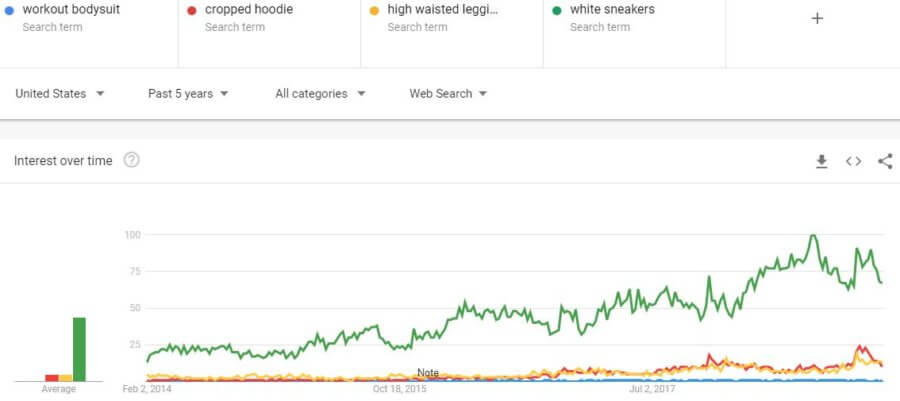
From what I see, workout bodysuits might be a trend that’s in its infancy. So, not offering much of a variety there wouldn’t affect sales too much.
Obviously, Foot Locker has no shortage of (cropped) hoodie options. So they seem to be on top of things in that respect. But, according to Google Trends, high-waisted leggings are just as trendy as cropped hoodies. Foot Locker’s selection there was, in my opinion, pretty poor.
It’s the seeming lack of trendy options in white sneakers that surprises me the most. The Google Trends chart shows that this trend is by the most searched for out of the four. Yet, Foot Locker didn’t seem to have some of the most popular styles.
If Foot Locker manufactured its own clothes and shoes, I could maybe understand having a wait-and-see approach to trends. However, since they are a retailer, I wouldn’t think that they are taking much risk in trying to ride these trends. Particularly since new items can be offered “online-only” there wouldn’t be a need to stock inventory at all 3,310 stores.
With an idea of Foot Locker’s trendiness in terms of product, let’s see what we can find in terms of operational trendiness.
Operational trends
These trends will take a little more investigative work. Information about these sorts of things may or may not be made available on the company’s website. I’ll start by familiarizing myself with examples of these sorts of things; then I’ll dig around to get a feel for Foot Locker’s level of participation.
Online to offline
From what I can tell, online to offline, basically means that a company integrates online/mobile capabilities with their brick-and-mortar stores. Things such as augmented reality, in-store pickup/returns, and Bluetooth beacons are examples.
Foot Locker didn’t have a strong showing in this trend. If I read right – refund/exchanges of online purchases were allowed in-store. It wasn’t made abundantly clear. This information was buried at the bottom of the FAQ page. Almost as if they didn’t want customers to know.
Store pickup for some online purchases is available. I tested a few popular items just to see for myself. You have to click on the “find in-store” button to see if store pickup is available. Some were, some weren’t.
To me, any opportunity you can get to re-market to a customer is positive. So, why not take advantage of it? Even if somebody is returning something – you get them in the store and have a chance to save the sale. Plus, with “porch pirates” being such a problem – why not allow people to pick up their purchases at your physical location? Seems like an opportunity to make an upsell to me.
Customer privacy
One advantage brick-and-mortar stores have over online shopping is that at a brick-and-mortar store – you could stroll in, pay with cash, and the retailer would have no idea who you were. Now, the convenience of online shopping comes at a cost. That cost can range from intrusive marketing to stolen identities.
So, companies have to walk a tightrope of sorts now. Obviously, payment information is going to be necessary to complete transactions for the foreseeable future. Additionally, the gathering of certain personal information can make the online shopping experience more personalized and enjoyable. The challenge is collecting just the right amount of personal information while keeping it safe.
Using a benchmark
The principles of consumer privacy listed on this site seemed like a good benchmark to judge Foot Locker’s Privacy statement against.
For the most part, Foot Locker addresses all of those principles. On oddity that stuck out to me was regarding the security of information. Any of the paragraphs on the Privacy Statement page the mentioned “security” also referenced Kids Foot Locker. I suppose that the page probably copied from the Kids Foot Locker Privacy Statement. But, for a company of Foot Locker’s size, I would assume that these sorts of details wouldn’t be overlooked.
Another concern was the information disclosed to third parties. I know that’s a not-too-uncommon practice, but it seems needlessly risky to potentially be liable for a security breach at another company. The information shared might only include demographic information and email addresses. But, if it were to include very personal information, that would make me uncomfortable, personally.
Finally, there is no mention of employee responsibility or elaboration on what makes a third party partner “carefully-selected.” If Foot Locker were just one individual – you could easily decide if you trust them or not. But, Foot Locker and its “carefully-selected” partners are comprised of thousands of individuals. Many of which will have the opportunity to get access to your personal information.
A Privacy Policy is only as good as the company who writes it. Foot Locker’s is pretty boilerplate and seems to exist so that they say they have one. It’s better than ignoring customer privacy, but it could address customer concerns more in-depth. Ultimately, it’s their actions that will determine their commitment to customer privacy – not their words.
Loyalty program
The notion that it’s easier (and cheaper) to keep a customer than to get a new one, is something we’ve all heard. Loyalty programs exist for that reason. To encourage repeat purchases and keep customers coming back for more.
Having a loyalty program would not, on its own, seem to be enough. The loyalty program has to…inspire loyalty.
Here’s a good post on loyalty programs in the retail fashion industry. This post makes note of a couple of good examples that can serve as benchmarks. Additionally, three tips are listed at the bottom that will serve as good tests for Foot Locker.
Foot Locker meets tip 3, in that they have a loyalty program. It’s called “VIP.” Benefits include:
- A $10 coupon, just for signing up
- Early access to certain products
- Exclusive (?) coupons throughout the year
- “Platinum status” (more rewards…) by spending $300 per year
No mention of Pinterest, but Foot Locker does give rewards. However, they aren’t necessarily the type that competitors can’t replicate.
I found this post, from the same site as above – written specifically about the Foot Locker VIP program. The author mentions how he likes the $10 off coupon and the accompanying app. On the flip side, he doesn’t care for the easy-to-reach Platinum status and the lack of promotion by Foot Locker
On the last point, I agree. The VIP program is mentioned on Foot Locker’s home page, but text and links to learn more are tucked away in the corner or in the footer menu. Foot Locker’s other sites seemed to follow suit.
Overall, it seems like Foot Locker acknowledges the importance of a loyalty program, but goes about running one somewhat halfheartedly. A stance that’s not all that different from the one they have on customer privacy.
So, is Foot Locker riding industry trends?
Overall, I’m not convinced that Foot Locker has positioned itself to ride the tailwind of current trends. Neither from a product standpoint or an operational one.
Granted, my list of trends wasn’t completely comprehensive. My searches were for “2019 trends.” There are probably trends from previous years that Foot Locker is capitalizing on. Maybe, at this point, those trends have matured – but they still represent an opportunity for significant sales.
Admittedly, some of the product trends I researched are probably still in their infancy. Things that people think will be hot over the coming year.
As far as the operational trends go (particularly customer privacy and loyalty programs), Foot Locker also had a pretty ho-hum showing. I think these operational trends are less speculative than the product trends and Foot Locker seems to treat them as an afterthought.
When all is said and done, I can only work with the information and the tools I have. Spending the rest of my life learning about the athleisure industry so that can ascertain Foot Locker’s trendiness isn’t practical. I committed, what I feel to be, adequate time to research the subject. What I’m left with, is a general dissatisfaction with Foot Locker’s ability to reach their potential in the market.
This is why I think it’s beneficial to focus on a handful of particular industries if you’re going to commit to fundamental analysis of stocks. If, for instance, I moved on to research Dick’s Sporting Goods or The Finish Line, I’d have a leg up. I wouldn’t have to start from scratch. I’d know better what to look for and where to find the information I needed. In short, I’d be more efficient in my analysis.
Is the company you’re researching benefiting from emerging industry trends?
This was a beast of a post! I didn’t want to just tell you what I think you ought to do when it comes to analyzing trends – I wanted to do it too. I wanted to see how practical my advice was. Though I only focused on a handful of trends for Foot Locker, there was a lot of information to sort through.
What did I miss?
What are some other good sources to find industry trends?
Did I misinterpret something about Foot Locker?
Join the conversation on Twitter!
Contents
- Is Foot Locker capitalizing on industry trends?
- “Athleisure trends 2019”
- “Retail industry outlook 2019”
- What does Google Trends have to say about what I found?
- “Striped leggings” and “stripe yoga pants”
- “Fitness jumpsuit,” “workout bodysuit,” and “yoga jumpsuit”
- “Floral print leggings” and “high waisted leggings”
- “Tech fleece joggers” and “cropped hoodie”
- “Online to offline,” “customer privacy,” and “loyalty program”
- What about sneakers?
- “White sneakers,” “classic sneakers,” and “technical sneakers”
- Let’s take a look at Trendhunter
- How trendy is Foot Locker?
- So, is Foot Locker riding industry trends?
- Is the company you’re researching benefiting from emerging industry trends?

